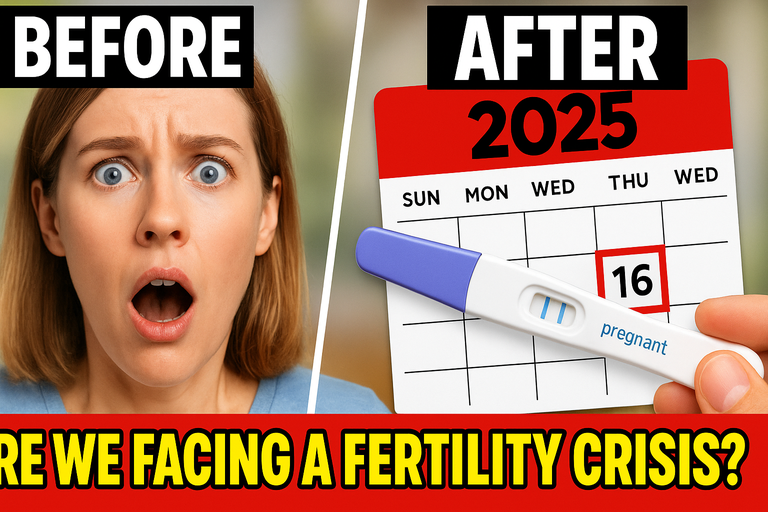
Let’s be real—a few decades ago, growing your family was considered almost a given. Now? Getting pregnant can feel like solving a cryptic puzzle… with half the pieces missing.
You might’ve already seen it—the headline from BBC News about the United Nations warning of an “unprecedented decline” in global fertility rates (read it here). It’s everywhere, and for anyone hoping to welcome a little one, it lands like a gut punch: Hundreds of millions can’t have the number of children they want.
But what does this global crisis actually mean for you and me—the real humans trying (and hoping, and obsessively Googling) to conceive?
Why Is Everyone Talking About Fertility—And Should You Worry?
First, let’s unpack the headline. The UN isn’t just talking about a few countries. We’re seeing falling fertility rates across the globe: from bustling cities to quiet suburbs, more couples are struggling to have the families they dream of. Social media is lighting up with hashtags like #fertilitystruggles and #ttc (that’s “trying to conceive,” for the uninitiated).
It’s not just a “them” problem—it’s an “us” thing too. If you’ve ever felt alone staring at a negative pregnancy test or wondering why the universe seems to hand out babies like party favors to everyone but you, you’re actually one of millions in the same boat. And the reasons? They’re complicated:
- Later-in-life parenthood. Careers, travel, the cost of living—most of us just aren’t starting families at 22 anymore.
- Environmental factors. Pollution, lifestyle stress, and nutrition all make a difference.
- Medical and genetic issues. PCOS, endometriosis, low sperm count, and more.
- Societal shifts. Changing definitions of family, more inclusivity, and new paths to parenthood.
The Emotional Whiplash of Trying to Conceive
Here’s the part nobody tells you: every headline about declining fertility rates can feel like a personal attack. It’s not enough to track ovulation, overhaul your diet, and (sometimes awkwardly) schedule intimacy around the full moon—you’re also battling the anxiety and uncertainty that comes with globally shifting odds.
I’ve sat with friends at kitchen tables surrounded by half-drunk cups of herbal tea and a pile of ovulation sticks, grappling with that persistent, internal voice: Is it me? Why is this so difficult? Is it ever going to happen?
If that resonates, stop. Take a breath. What’s happening globally matters, yes, but your journey is uniquely yours. And right now, more resources and support exist than ever before.
The Home Conception Revolution: Can We Really Take Control?
Here’s where things get interesting. Facing these daunting statistics, an entire movement is bubbling up under the radar: at-home conception support.
I stumbled across MakeAMom’s home insemination kits in a late-night spiral (you know the one—3 a.m. forums, fertility apps, and snack crumbs everywhere). I was surprised by how empowering it felt to see people taking charge, moving away from sterile clinics, and bringing conception—literally—home.
Their kits aren’t just for traditional couples. They include options for single parents by choice, same-sex couples, and anyone dealing with challenges like low sperm motility or sensitivities. And unlike disposable kits, these are reusable, discreet, and (hallelujah!) way less expensive over time. It’s about privacy, agency, and support—exactly what’s needed when the world feels out of control.
Still Skeptical? Let’s Talk Science (And Success!)
It’s natural to be wary—does any of this really work? According to MakeAMom, the average success rate for users of their home insemination systems is an impressive 67%. That’s not magic, it’s science—knowing your cycle, using the right tools, and supporting your body emotionally and physically.
Here’s what I found most reassuring: - Tested kits for different needs. CryoBaby for frozen sperm, Impregnator for low motility, BabyMaker for those with sensitivities. - Plain, non-identifiable shipping. Privacy matters! - Resources and real-life testimonials. Sometimes, the best advice comes from fellow travelers on this bumpy road.
5 Actions You Can Take Now to Support Your Fertility Journey
Fertility rates may be dropping, but that doesn’t mean your hope has to. Here’s what’s working for modern families: 1. Track your cycle—but don’t let it rule your life. Knowledge is power, but self-kindness is survival. 2. Consider at-home insemination kits for a supportive, private, and cost-effective path. 3. Prioritize emotional wellness. Join forums, talk to a counselor, start a journal. 4. Get real with nutrition and lifestyle. Small changes = big impact. 5. Stay informed—but take breaks from the doomscrolling. The big picture matters, but so does your peace of mind.
Final Thoughts: You’re Not Alone—And Your Family Dream Still Matters
Reading about the world’s “unprecedented decline” in fertility can be scary, but it’s also a call to action. Yes, the journey looks different in 2025—more complicated, more emotional, sometimes more lonely. But it’s also more possible than ever to take charge, find your own path, and write your own happy ending.
Have you tried an at-home insemination kit or found community in unexpected places? Let’s share our stories. Drop your thoughts below—because your journey, with all its twists and turns, might be exactly the reassurance someone else needs today.
You’re not just a statistic. You’re a hopeful parent-to-be, and that’s the most important story of all.